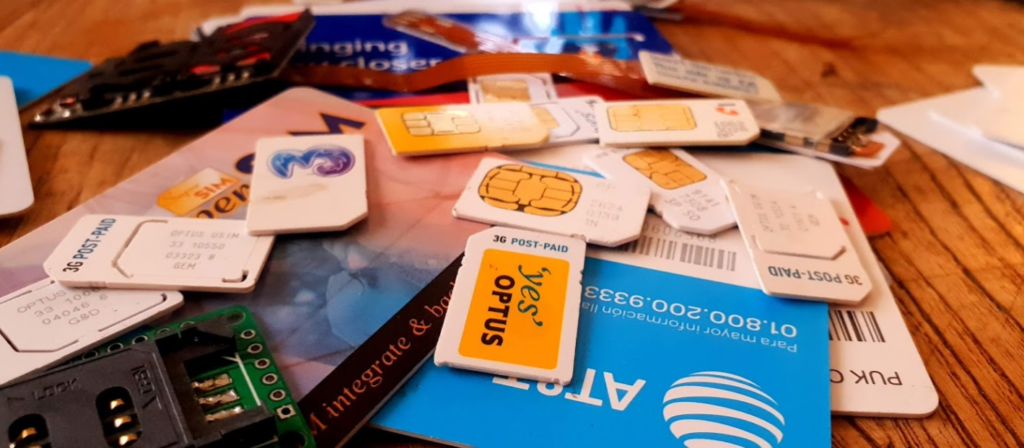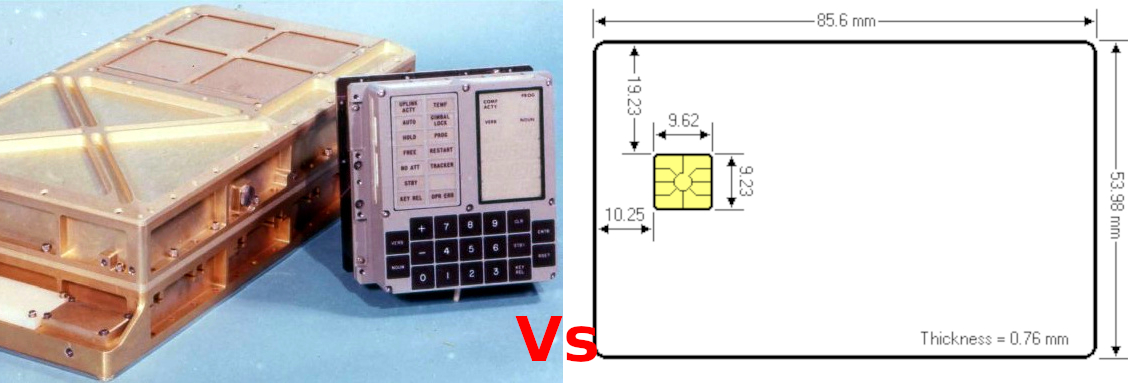The first thing people learn about SIMs or the Smart Cards that the SIM / USIM app runs on, is that “There’s a little computer in the card”. So how little is this computer, and what’s the computing power in my draw full of SIMs?
So for starters the SIM manufacturers love their NDAs, so I can’t post the chip specifications for the actual cards in my draw, but here’s some comparable specs from a seller selling Java based smart cards online:

4K of RAM is 4069 bytes.
For comparison the Apollo Guidance Computer had 2048 words of RAM, but each “word” was 16 bits (two bytes), so actually this would translate to 4069 bytes so equal with one of these smart cards in terms of RAM – So the smart card above is on par with the AGC that took humans to the moon in terms of RAM, althhough the SIMs would be a wee bit larger if they were also using magnetic core memory like the AGC!
The Nintendo Entertainment System was powered by a MOS Technology 6502, it had access to 2K of RAM, two the Smart Card has twice as much RAM as the NES, so it could get you to the moon and play Super Mario Bros.
What about comparing Non-Volatile Memory (Storage)? Well, the smart card has 145KB of ROM / NVM, while Apollo flew with 36,864 words of RAM, each word is two bits to 73,728 Bytes, so roughly half of what the Smart Card has – Winner – Smart Card, again, without relying on core rope memory like AGC.

SIM cards are clocked kinda funkily so comparing processor speeds is tricky. Smart Cards are clocked off the device they connect to, which feeds them a clock signal via the CLK pin. The minimum clock speed is 1Mhz while the max is 5Mhz.
Now I’m somewhat of a hoarder when it comes to SIM Cards; in the course of my work I have to deal with a lot of SIMs…
Generally when we’re getting SIMs manufactured, during the Batch Approval Process (BAP) the SIM vendor will send ~25 cards for validation and testing. It’s not uncommon to go through several revisions. I probably do 10 of these a year for customers, so that’s 250 cards right there.
Then when the BAP is done I’ll get another 100 or so production cards for the lab, device testing, etc, this probably happens 3 times a year.
So that’s 550 SIMs a year, I do clean out every so often, but let’s call it 1000 cards in the lab in total.
In terms of ROM that gives me a combined 141.25 MB, I could store two Nintendo 64 games, or one Mini CD of data, stored across a thousand SIM cards – And you thought installing software from a few floppies was a pain in the backside, imagine accessing data from 1000 Smart Cards!
What about tying the smart cards together to use as a giant RAM BUS? Well our 1000 cards give us a combined 3.91 MB of RAM, well that’d almost be enough to run Windows 95, and enough to comfortably run Windows 3.1.
Practical do do any of this? Not at all, now if you’ll excuse me I think it’s time I throw out some SIMs…

Is it possible to register an eSIM from a commercial UE to a non-commercial/lab network? Given that the commercial eSIM can be provisioned with the right info, Could the UE register and connect to a private/lab VoWiFi network without ever involving the LTE/5G radio (Only using VoWiFi). Or is a Connection to an actual LTE/5G basestation required to register most commercial UEs even with eSIM?
sorry for the unrelated question.
Sure, we’ve got a few eSIMs in our lab, but the catch is you still need an SMDP+ to activate the eSIM, you can do it without cellular coverage, but you’ll still need the SMDP+ which is the tricky part, as the certificates it uses have to be signed by the GSMA.
Hi
I use eSIM created with the ki/opc that I know for my lab hss. However the installation is in SM-DP+ live environment for that reason Nick mentioned.
Cheers
Right that is tricky indeed, Very cool that it works though. Found this site recently, love the posts very informative stuff. Thanks for the response.
The processing capability of a SIM is totally dependant on what processor is embedded into it and the amount of memory included.
The majority of SIMs are configured for the absolute bare minimum required to do the job – in order to keep the cost down – but if one has a slightly larger budget, it is possible to obtain specialist SIMs with much greater capability….